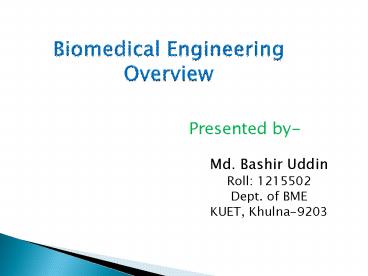Biomedical Engineering Overview - PowerPoint PPT Presentation
1 / 17
Title: Biomedical Engineering Overview
1
Biomedical Engineering Overview
- Presented by-
- Md. Bashir Uddin
- Roll 1215502
- Dept. of BME
- KUET, Khulna-9203
2
What is Biomedical Engineering ?
- Engineering sciences Biomedical sciences
- Clinical practice Biomedical Engineering
- Engineering Biology Medicine
- Biomedical
Engineering - Design and problem solving skills of engineering
- Medical Biological
sciences - Biomedical
Engineering - Engineering technology for the solution of
Medical -
Problems - Biomedical Engineering
3
Applications of Biomedical Engineering
- Applications are almost endless and developing
every day that it includes - Cardiac monitors to clinical computing
- Artificial hearts to contact lenses
- Wheel chairs to artificial tendons
- Modeling dialysis therapy to modeling the
cardiovascular system.
4
Biomedical Engineers
Biomedical Engineers
Engineering Techniques
Medical Problems
Analysis
Solution of Medical Clinical Problems
Improve Healthcare Diagnosis, Monitoring and
Therapy.
5
Duty of Biomedical Engineers
- Designing medical instrument
- Contribute in the development, manufacturing and
testing of medical products - Maintain and enhance life of medical instrument
- Designing prostheses
- Designing replacement parts for people
- Creating systems to allow the handicapped to
function, work and communicate - Managing the technology in the hospital system.
- Saling biomedical instruments
- Etc.
6
Career Opportunities for Biomedical Engineers
- Biomedical engineers come from one of the
traditional engineering disciplines, such as
electrical or mechanical engineering. - Biomedical engineers are exposed to many fields
of study in engineering, medicine and biology.
Due to this broad experience biomedical engineers
find employment in
- Hospitals
- Clinics
- Diagnostic Centers
- Government bodies
- Industry
- Academic areas
- Research etc.
7
Main Fields of Biomedical Engineering
8
New fields of Biomedical Engineering
- Medical electronics
- Clinical engineering
- Rehabilitation engineering.
9
Medical Instrumentation
- Medical instrumentation is the application of
electronics and measurement techniques to develop
devices used in diagnosis and treatment of
disease.
- Computers are an important and increasingly
essential part of medical instrumentation - Examples of medical instrumentation include
heart monitors, microelectrodes, defibrillators,
glucose monitoring machines etc.
10
Biomaterials
- Biomaterials are defined as the materials used
for medical implantation includes both living
tissue and artificial materials.
- Examples of biomaterials include
- Heart replacement valves
- Artificial lungs
- Artificial kidneys
- Dental adhesives
- Bone cement
- Replacement bones/joints
- Heart prosthetics
- Etc.
11
Biomaterials (cont.)
- Biomaterials must have following properties
- Nontoxic
- Non-carcinogenic
- Chemically inert (not reacting violently with the
body's chemical composition) - Stable
- Mechanically strong enough to withstand the
repeated forces of a lifetime of use.
12
Human Physiology and Modeling
- Human Physiology is the study of the body and
its functions in each of the different systems in
any living body
- Modeling is used in the analysis of experimental
data and in formulating mathematical descriptions
of physiological events
Examples Biochemistry of metabolism and the
control of limb movements
13
Bio-Signal processing
- Collection and analysis of data (signal) from
patients - The manipulation and dissection of the data or
signal provides the physician and experimenter
the vital information on the condition of the
patient. - Biomedical Engineers apply signal-processing
methods to the design of medical devices that
monitor and diagnose certain conditions in the
human body. - Examples Heart arrhythmia detection software and
brain activity
14
Medical Imaging
- Medical Imaging combines knowledge of a unique
physical phenomenon (sound, radiation, magnetism
etc.) with high-speed electronic data processing,
analysis and display to generate an image.
- Examples
- Magnetic Resonance Imaging (MRI)
- Ultrasound and computed tomography (CT).
15
Biomechanics
- Biomechanics applies both fluid mechanics and
transport phenomena to biological and medical
issues. - It includes the study of motion, material
deformation, flow within the body, as well as
devices, and transport phenomena in the body,
such as transport of chemical constituents across
biological and synthetic media and membranes. - Efforts in biomechanics have developed the
artificial heart, replacement heart valves and
the hip replacement.
16
Rehabilitation Engineering
- Rehabilitation engineering is the systematic
application of engineering sciences to design,
develop, adapt, test, evaluate, apply, and
distribute technological solutions to problems
confronted by individuals with disabilities. - Functional areas of rehabilitation engineering
may include mobility, communications, hearing,
vision, and cognition, and activities associated
with employment, independent living, education,
and integration into the community.
17
THANK YOU































